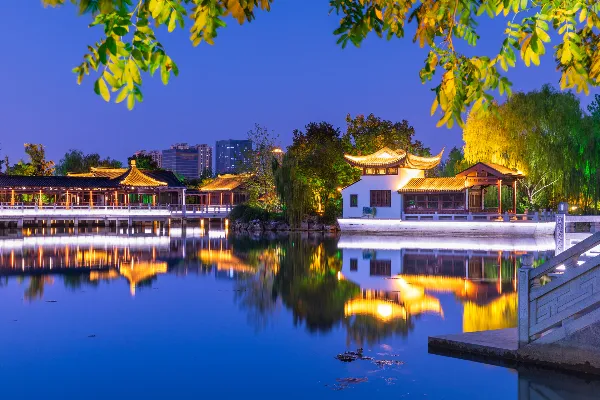
Encircling Nantong's old town in Jiangsu Province, this 5A-rated national scenic area preserves China's most intact ancient moat system. Dating back to the Five Dynasties period, the 10km-long waterway covers 72 hectares with an average width of 215m (max 400m), embracing the historic district like a liquid belt. Along its banks stand 28 historical structures from Ming to Republican era - including 7 bridges, 5 sluice gates and 3 city wall sections - while its museum cluster earns the title "City of Museums in Miniature".
History & Culture
First dug in 958 AD during Later Zhou Dynasty, the moat was expanded during Ming's anti-pirate campaigns before becoming a salt transport hub studded with guildhalls in Qing era. Industrialist Zhang Jian established China's first normal school and public museum here - the Nantong Museum complex still preserves 1912 British-style buildings. During WWII, its sluice system ingeniously blocked Japanese warships; the surviving Xibei Gate remains manually operable, a living fossil of hydraulic engineering.
Key Attractions
Nantong Museum - China's first public museum (founded 1905) houses 37 national treasures including Zheng Banqiao's bamboo paintings. Zhang Jian's former residence Haonan Villa features French-style gardens with century-old wisteria cascades every April.
Huanxi Cultural Plaza - Built over Ming watergate ruins, this waterfront stage hosts nightly holographic show "Haohe Through Millenniums". Glass walkways reveal 2.6m-wide ancient wall foundations with stratified deposits from Tang to Qing dynasties.
Tianning Temple & Guangxiao Pagoda - This Zen Buddhist complex (est. 863 AD) centers around a seven-story octagonal pagoda with Yuan dynasty murals. When wind chimes on the pagoda harmonize with temple bells, it creates a unique "Pagoda Chant" soundscape.
Night Cruise - Antique-style boats sail the "Museum Golden Route" past 8 cultural sites including Indigo Fabric Museum. The specially-designed "Twin Pagodas Reflection" course aligns Song-era Wenfeng Pagoda with a modern TV tower in perfect mirrored symmetry.
Culinary Delights
Nantong Jump Noodles - Qing-era specialty where chefs jump on bamboo poles to knead dough, served with clam broth. Watch the process at century-old Siyi Cake Shop.
Huangqiao Sesame Cakes - Flaky pastries with radish or pork floss fillings, famed as military rations during 1940 Huangqiao Campaign, traditionally baked at Yizhulou Restaurant.
Yangtze Three Delicacies - Seasonal feast of swordfish, shad and pufferfish. "Spring Plum Grove" chefs hold pufferfish cooking licenses, offering 24-course fugu banquets.
Shigang Fermented Tofu - Aged in century-old cellars following "spring starter, summer ferment, autumn sun-dry" methods, available in innovative osmanthus-sesame flavors at souvenir shops.
Travel Guide
Start your day at Nantong Museum exploring Zhang Jian's legacy, then savor river delicacies at "Jianghai Fishing Port" by Huanxi Plaza. Afternoon visits to Tianning Temple lead to evening cruises from Pier 3. Choose between combo tickets (¥120 for 6 sites) or individual entries (Museum ¥30, Cruise ¥60). Take Metro Line 1 to Youyiqiao Station (Exit 4), or park at museum's underground lot (¥5/hour). Don't miss Saturday 8 PM pagoda light shows - best viewed from "Pagoda Reflection" cruise route.
Pro Tips
April-May offers ideal conditions with weeping willows and wisteria in full bloom. Weekdays see 1/3 the weekend crowds. Book cruises 1 day ahead for golden hours (6:30-7:30 PM). Photographers should arrive at "Twin Pagodas" viewpoint by 6 AM for misty reflections. Mind slippery flagstones after rain. Consider combo tickets with nearby Wolf Mountain Scenic Area for 20% savings if time permits.
